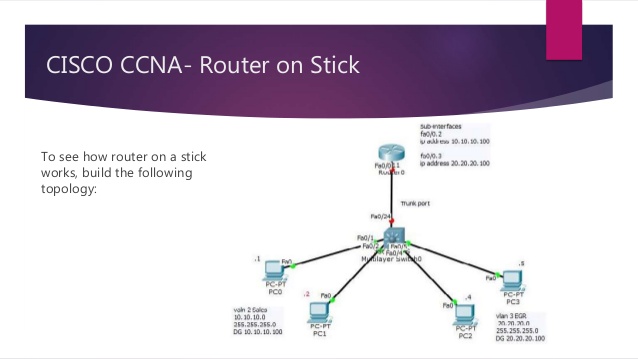

- #CISCO ROUTER ON A STICK WITH NAT PRO#
- #CISCO ROUTER ON A STICK WITH NAT MAC#
- #CISCO ROUTER ON A STICK WITH NAT WINDOWS#
The UniFi Switch Pro 48 is an ideal aggregation and access layer switch for any UniFi solution – it combines innovative near-silent cooling with UniFi SmartPower RPS power Managed and configured by the UniFi Controller with UniFi Mobile app support, the UniFi Switch offers an extensive suite of advanced Layer-3 switching protocols and features, including operation mode (switching, mirroring, or aggregate) per port, Inter-VLAN routing, static routing, and DHCP server. The USW Pro 48 PoE is the ideal access layer switch for any UniFi system. In NAT mode, the FortiGate unit supports VLAN trunk links with IEEE 802. This switch can be monitored or configured from anywhere with the powerful, intuitive UniFi Network web application and mobile app. Configure the VLAN as shown in Figure Edit VLAN. The switch assigns any untagged frame that arrives on a tagged port to the native VLAN. 1: Using A Router With 2 Ethernet Interfaces. Create a new rule that Drops or Rejects 2 with the configuration shown below. I recently setup a UDM pro with two networks: LAN (default network) Media (Separate VLAN) I understand that by default, devices on 'Corporate' networks, even when on different VLANs are able to talk to each other.
#CISCO ROUTER ON A STICK WITH NAT WINDOWS#
Configure DHCP on Windows Server for all VLANs except wireless 5. All we need to do is go to settings, services, then mDNS and turn on multicast DNS. vlan database vlan 10,20 vlan routing 10 vlan routing 20 exit 3. Ubiquiti UniFi Switch PRO Gen 2 – 48 poort. In this failure scenario, one server is connected to a switch, and the port duplex mode is configured half-duplex on the server side and full-duplex on the switch side. Ubiquiti Unifi with Sonos on a separate VLAN May 22, 2020. 0) / Ports 21 - 28 The devices in each VLAN are allowed to communicate with devices in other VLANs because routing is enabled on the switch. Multiple sites are no longer supported on UDM platforms. Note the following: The trunk port carries all tagged VLAN traffic from the switch to OPNsense The hybrid port carries the tagged traffic of VLANs 20, 30, and 40 made available by the UniFi access point (AP) via WiFi. The default gateways are configured as follows: vlan "101" is 192. While you can create your own firewall rules that mimic the parental controls that AmpliFi provides AmpliFi vs. We also allow untagged VLAN 10 traffic because UniFi devices must communicate over an untagged network to be adopted by a UniFi controller. The non-pro models are fanless and have very limited PoE budgets.
#CISCO ROUTER ON A STICK WITH NAT MAC#
Ya kind of already did that with mac filtering ) While mac filtering is a method of control, which is how you seem to be using it. Ease the configuration process for VLANs, as a separate router isn’t required between each VLAN. The third option for routing traffic between VLANs is to use a Layer 3 switch. There are three models in this series, the RV260, RV260P, and RV260W. Mac filtering is fine as a simple method of controlling the ability of users to add different devices to the network that The UniFi way of routing between VLANs is to use a UniFi Security Gateway. * q VLAN configuration is learned by the switches q Stations do not belong to VLANs, packets do.

I'm having a hard time doing it.Inter vlan routing unifi L2 Features > VLAN > 802. The other end is dropping the packets since they aren't protected.īasically, I just want a VPN setup between me and someone else. So, traffic is sourced from one place, and sent back the other way. The problem in my setup lies with FTP, having no direct route to 192.168.1.50, using the default route, which is 10.0.0.1. 2611 has an access-list mapping any traffic destined for FTP to the protected tunnel.ġ841 then takes the protected traffic and sends it out to FTP. For the example, let's assume all the IPs I list are real-world IPs, and not private network IPs. This router has an address of 192.168.1.50.

On the remote end, I have the 2611 (here-on referred to as 2611). From here on, I'll call the router 1841 and the FTP server FTP. The IP address of the FTP server is 10.0.0.2. The 1841 is my endpoint where we have protected service, namely FTP. I have two routers, one 2611 and one 1841. However, here's what I hope is a more clear, more thorough, explanation. I explained my reasoning for NAT on the VPN traffic above.


 0 kommentar(er)
0 kommentar(er)
